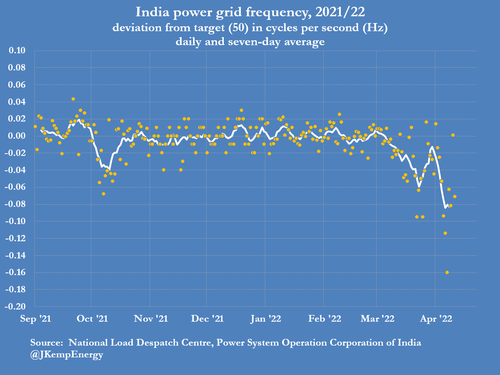India Facing Widespread Blackouts This Summer
India faces a persistent shortage of electricity over the next four months as rapid demand growth from air conditioners overwhelms the available generation on the network.
India’s grid reported a record load of 200,570 megawatts on July 7, 2021, at the height of last summer, according to the National Load Despatch Centre of the Power System Operation Corporation (POSOCO).
But since the middle of March, the grid has routinely reported maximum loads above 195,000 MW, including a peak of 199,584 MW on April 8 – less than 0.5% below the record.
In the evening, when there is no solar generation available and supplies are even more stretched, peak loads have hit a new record in recent days.
Exceptionally high loads have arrived far earlier this year, well before the most intense period of summer heat, implying the grid is in trouble.
In a symptom of the struggle to meet demand, the grid’s frequency has faltered since mid-March, dropping persistently below target, with longer and more severe excursions below the safe operating range.
Chronic under-frequency is a sign the grid cannot meet the full demand from customers and makes planned load-shedding or unplanned blackouts much more likely.
India has a frequency target of 50.00 cycles per second (Hertz), with grid controllers tasked with keeping it steady between 49.90 Hz and 50.05 Hz to maintain the network in a safe and reliable condition. Since the middle of March, frequency has averaged just 49.95 Hz and has been below the lower operating threshold more than 23% of the time.
On April 7, the average frequency fell as low as 49.84 Hz and frequency was below the lower threshold for 63% of the day, according to POSOCO data.
Frequency has been below target so often for so long in recent weeks it has sometimes appeared the system is operating according to a much lower informal target.
…click on the above link to read the rest of the article…
